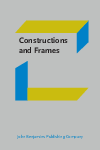
Constructions and Frames
Scope & Guideline
Exploring the intricate structures of language.
Introduction
Aims and Scopes
- Construction Grammar:
The journal promotes research on Construction Grammar, emphasizing how linguistic constructions shape and are shaped by usage, with an eye on both synchronic and diachronic perspectives. - Usage-based Approaches:
It prioritizes usage-based methodologies that analyze language data to uncover patterns and principles governing the formation and evolution of constructions. - Cross-linguistic Studies:
The journal encourages comparative studies across languages, examining how constructions operate within various linguistic frameworks and cultures. - Cognitive and Philosophical Perspectives:
The inclusion of cognitive and philosophical reflections on grammar highlights the journal's commitment to understanding the theoretical implications of constructionist views. - Interdisciplinary Research:
The journal welcomes interdisciplinary approaches, integrating insights from fields such as cognitive science, philosophy, and social linguistics to enrich the study of constructions.
Trending and Emerging
- Integration of Large Language Models:
Recent papers are exploring the intersection of usage-based approaches and large language models, indicating a growing interest in how computational linguistics can inform construction grammar. - Philosophical and Reflective Insights:
There is an increasing trend towards philosophical reflections on the implications of construction grammar, suggesting a deeper engagement with theoretical questions about language. - Diachronic Constructional Change:
Research focusing on diachronic changes in constructional networks is gaining prominence, emphasizing the historical evolution of constructions and their semantic implications. - Multilingual and Cross-disciplinary Approaches:
Emerging themes include multilingual perspectives and interdisciplinary research that connect constructions with cognitive science, social contexts, and other areas of study. - Usage-based Characterizations:
A strong trend towards usage-based characterizations of various constructions shows the journal's commitment to empirical data and real-world language use.
Declining or Waning
- Traditional Grammar Approaches:
There seems to be a decline in papers focusing on traditional grammar frameworks, as the journal increasingly embraces usage-based and constructionist perspectives. - Static Models of Language:
Research that relies on static models of language, which do not account for the dynamic nature of language change and usage, is appearing less frequently, indicating a shift towards more fluid and adaptable frameworks. - Morphological Studies:
Although still relevant, studies specifically centered on morphological schemas and traditional morphological analyses are becoming less common, as the emphasis shifts towards constructional and usage-based approaches.
Similar Journals

Revista Virtual de Estudos da Linguagem-ReVEL
Advancing Knowledge in Language StudiesRevista Virtual de Estudos da Linguagem-ReVEL is a prominent academic journal dedicated to the field of linguistics, published by REVISTA VIRTUAL ESTUDOS LINGUAGEM in Brazil. With its ISSN 1678-8931, ReVEL aims to provide a platform for scholarly communication and dissemination of research across diverse areas of language studies, including sociolinguistics, language acquisition, and discourse analysis. As an open-access journal, it fosters accessibility to important linguistic research, allowing researchers, educators, and students alike to engage with the latest findings without subscription barriers. The journal’s focus on innovative methodologies and interdisciplinary approaches makes it a valuable resource for those seeking to deepen their understanding of language dynamics in various contexts. By contributing to the growing body of knowledge in this field, ReVEL plays a crucial role in promoting scholarly dialogue and enhancing the visibility of Brazilian linguistic research on a global scale.
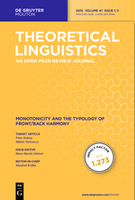
THEORETICAL LINGUISTICS
Advancing Understanding in Linguistic DimensionsTHEORETICAL LINGUISTICS, published by Walter de Gruyter GmbH, is a prominent journal dedicated to exploring the intricate dimensions of linguistics, positioning itself as an essential resource for scholars and practitioners in the field. Established in 1974, this Germany-based journal has undergone significant evolution, contributing to the theoretical and empirical understanding of language with a focus on diverse linguistic phenomena. As evidenced by its Q2 ranking in the Linguistics and Language category for 2023, THEORETICAL LINGUISTICS engages with innovative theoretical discussions and methodologies, making it a vital platform for researchers navigating the complexities of language structure and usage. Though not an open-access journal, it ensures accessibility through robust distribution networks, fostering collaboration and knowledge-sharing within the academic community. With a consistent output from 1990 to 2024, this journal stands at the intersection of linguistics and language studies, appealing to a wide audience of researchers, professionals, and students alike.

Journal of Portuguese Linguistics
Advancing Knowledge in Portuguese LinguisticsThe Journal of Portuguese Linguistics is an esteemed peer-reviewed academic journal published by UBIQUITY PRESS LTD, dedicated to the exploration of the rich complexities of the Portuguese language and its various linguistic dimensions. With an ISSN of 1645-4537 and an E-ISSN of 2397-5563, this open-access journal has been disseminating valuable research since 2002, ensuring that knowledge is accessible to all scholars, professionals, and students interested in Linguistics. Based in Portugal, it features a distinct focus on the linguistics pertinent to the Portuguese language, facilitating discussions that span theoretical and applied interests. The journal holds a respectable Q3 quartile rank in the field of Linguistics and Language, reflecting its growing significance and contribution to academia, as evidenced by Scopus rankings that place it in the 71st and 68th percentiles in Arts and Humanities as well as Social Sciences. Researchers and practitioners alike will find Journal of Portuguese Linguistics to be an indispensable resource for fostering discourse and innovation in the study of language.

Jezikoslovlje
Connecting Researchers to Contemporary Linguistic ChallengesJezikoslovlje, published by the Josip Juraj Strossmayer University, Faculty of Philosophy in Croatia, is an essential publication in the field of Linguistics and Language Studies. Launched in 2008 and extending its contributions to the academic community through 2024, this journal addresses a spectrum of linguistic research, facilitating scholarly dialogue around both theoretical and applied aspects of language. With a current Scopus ranking placing it in the 54th percentile in the Arts and Humanities and the 50th percentile in Social Sciences, Jezikoslovlje serves as a vital resource for researchers and students looking to engage with contemporary linguistic issues. Although it operates under a traditional access model, its indexed presence and rigorous peer-review process ensure that published works maintain a high scholarly standard, inviting contributions that advance understanding in this dynamic discipline. The journal's commitment to fostering knowledge in linguistics makes it a significant platform for academics in Croatia and beyond.

Lingue e Linguaggio
Illuminating the Intersections of Language and SocietyLingue e Linguaggio, published by SOC ED IL MULINO, is a distinguished academic journal in the field of Linguistics and Language, hailing from Bologna, Italy. With an esteemed Q2 ranking in its category as of 2023, this journal is recognized for its contributions to both the arts and humanities as well as social sciences, achieving notable positions within Scopus rankings. It serves as a vital platform for researchers, practitioners, and students interested in exploring various linguistic phenomena, language dynamics, and theoretical frameworks. Although it operates under a traditional subscription model rather than open access, its comprehensive array of studies and publications provides significant insights and fosters academic discourse. With a publication period extending from 2002 to 2024, Lingue e Linguaggio continues to be a key resource for advancing the understanding of language in contemporary contexts.
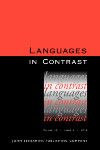
Languages in Contrast
Illuminating the Intricacies of Language ComparisonLanguages in Contrast, a distinguished journal published by John Benjamins Publishing Co, serves as a vital platform in the field of linguistics, particularly focusing on the comparative study of languages. Operating under the ISSN 1387-6759 and E-ISSN 1569-9897, this journal has established its significance, achieving a commendable Q2 ranking in the 2023 Linguistics and Language category, indicative of its strong impact and reputation within the scientific community. With a Scopus ranking of #294 out of 1167, positioning it in the 74th percentile of its field, it consistently publishes high-quality research that explores the nuances and contrasting features of various languages, fostering deeper understanding and knowledge sharing among researchers, professionals, and students alike. While the journal is not open access, its rigorous peer-review process ensures that the contributions it includes are both insightful and groundbreaking, making it an invaluable resource for anyone invested in the study of languages. With coverage extending from 2008 to 2024, Languages in Contrast is poised to continue its pivotal role in advancing linguistic research and scholarship.
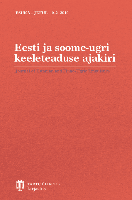
Eesti ja Soome-Ugri Keeleteaduse Ajakiri-Journal of Estonian and Finno-Ugric Linguistics
Championing Open Access to Linguistic DiscoveriesEesti ja Soome-Ugri Keeleteaduse Ajakiri - Journal of Estonian and Finno-Ugric Linguistics is a premier academic journal published by UNIV TARTU PRESS, dedicated to advancing the field of linguistics with a particular focus on the Estonian and Finno-Ugric languages. Since its inception, the journal has embraced an Open Access publishing model, allowing researchers and enthusiasts to freely explore its groundbreaking studies and findings since 2013. With an Impact Factor that places it in the Q3 quartile of leading journals within the linguistic domain, it serves as a vital platform for the dissemination of new research and theoretical advancements. Ranked 410th out of 1088 journals in the Arts and Humanities category for Language and Linguistics, it reflects a robust commitment to quality scholarship that appeals to academics, professionals, and students alike. Operating from Tartu, Estonia, the journal aims to foster greater understanding and appreciation of the Estonian language within the broader context of Finno-Ugric studies, making it an essential resource for anyone interested in these unique linguistic cultures.
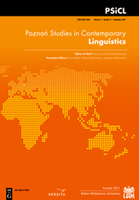
Poznan Studies in Contemporary Linguistics
Bridging theory and practice in language studies.Poznan Studies in Contemporary Linguistics, published by DE GRUYTER MOUTON, is a pivotal journal in the field of linguistics, with an ISSN of 0137-2459 and an E-ISSN of 1897-7499. Located in Germany, this esteemed journal has consistently contributed to the academic landscape since its inception. As of 2023, it holds a Q2 category rank in Linguistics and Language and boasts commendable Scopus rankings, featuring in the 69th percentile for Arts and Humanities and the 66th percentile for Social Sciences. The journal emerges as a vital platform for scholars to explore contemporary linguistic theories and practices, making it an essential resource for researchers, professionals, and students alike. With a converged publication period from 2007 to 2024, it aims to facilitate a deeper understanding of linguistic advancements and trends. While the journal currently does not offer open access, its rigorous peer-review process ensures the highest quality of published research, strengthening its role as a leading discourse in the dynamic field of linguistics.

Suvremena Lingvistika
Illuminating the Complexities of Language and Communication.Suvremena Lingvistika is a distinguished open-access journal published by the Croatian Philological Society, dedicated to advancing research in the field of linguistics and language. Since its establishment, the journal has been pivotal in promoting scholarly dialogue within the linguistics community, especially among researchers and academics in Croatia and beyond. With an ISSN of 0586-0296 and an E-ISSN of 1847-117X, the journal has transitioned to an open-access model since 2007, ensuring that research is freely accessible to all. As of 2023, it holds a respectable Q3 ranking in the Linguistics and Language category, reflecting its potential contribution to the field. The journal's scope encompasses a wide array of linguistic disciplines, encouraging both theoretical and empirical studies. Supportive of new research, Suvremena Lingvistika aims to foster innovative approaches and methodologies in linguistics, making it an essential resource for students, researchers, and professionals eager to explore the complexities of language. With its ongoing publication until 2024, it continues to shape the linguistic landscape, providing valuable insights and fostering collaboration among scholars globally.
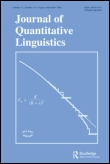
Journal of Quantitative Linguistics
Innovating Language Study with Empirical PrecisionThe Journal of Quantitative Linguistics, published by Routledge Journals, Taylor & Francis Ltd, stands as a pivotal resource in the field of linguistics, particularly in the rigorous application of quantitative methodologies to language research. Since its inception in 1994, this esteemed journal has contributed significantly to the understanding of linguistic phenomena through empirical data analysis, and it continues to maintain its esteemed Q1 ranking in the linguistics and language category as of 2023. Researchers and professionals will find a wealth of knowledge within its pages, as it publishes original articles, critical reviews, and methodological developments that push the boundaries of language study. While the journal is not open access, it remains widely accessible through institutional subscriptions, ensuring that a diverse readership can engage with the latest findings and theoretical advancements. As the journal looks forward to celebrating 30 years of impactful research by 2024, it remains dedicated to fostering discourse and innovation in the examination of language using quantitative approaches.